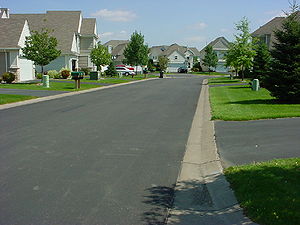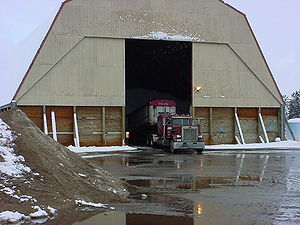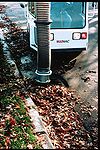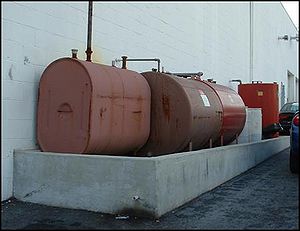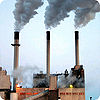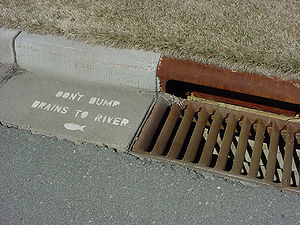
Pollution prevention
The 2008 version of the Stormwater Manual (Version 2) contains pollution prevention (P2) fact sheets for residential, municipal and commercial/industrial land uses. Material from those fact sheets comprises the information contained on this page. To link to the original document in Microsoft Word format, click File:Pollution Prevention.docx. In addition, there is a fact sheet for businesses. We anticipate eventually including information for specific pollution prevention practices.
For more information on pollution prevention in general, see MPCA's page on pollution prevention. The MPCA has also produced a document titled Pollution Prevention and the MS4 Program: A Guide on Utilizing Pollution Prevention Activities to Meet MS4 General Permit Requirements. This document provides communities regulated under the Minnesota Municipal Separate Storm Sewer Systems (MS4) General Permit with basic tools and information that will lead to increased use of pollution prevention (P2) activities within stormwater pollution prevention programs (SWPPPs) and local stormwater programs.
Contents
Residential Practices
Residential pollution prevention practices are household and neighborhood activities that prevent or reduce the contamination of stormwater. Residential pollution prevention practices prevent or reduce stormwater contamination from sources such as yards, driveways, sidewalks, and household products.
These practices are often simple, low cost behavioral changes that improve subwatershed water quality by minimizing the introduction of pollutants including sediment, nutrients, metals, bacteria, trash, oil, and toxins.
Each of these practices are highly suitable and effective in cold climates. Each practice varies in its ability to control pollutants generated from residential land uses. A variety of methods may be used for each of these practices. See Photo Credits and References for further information
This table shows a review of residential pollution prevention practices and the extent to which they control pollutants. Source: modified from the Center for Watershed Protection.
Link to this table
| Practice | Stormwater Pollutants Controlled | ||||||
|---|---|---|---|---|---|---|---|
| Sediment | Nutrients | Metals | Bacteria | Trash | Oil | Toxins | |
| Fertilizer and Pesticide Management | Uncontrolled | Significantly Controlled | Uncontrolled | Uncontrolled | Uncontrolled | Uncontrolled | Significantly Controlled |
| Litter and Animal Waste Control | Uncontrolled | Significantly Controlled | Uncontrolled | Significantly Controlled | Significantly Controlled | Uncontrolled | Uncontrolled |
| Yard Waste Management | Moderately Controlled | Significantly Controlled | Uncontrolled | Slightly Controlled | Slightly Controlled | Uncontrolled | Uncontrolled |
| Household Hazardous Waste Control | Uncontrolled | Slightly Controlled | Significantly Controlled | Uncontrolled | Uncontrolled | Significantly Controlled | Significantly Controlled |
| Alternative Product Use | Uncontrolled | Uncontrolled | Uncontrolled | Uncontrolled | Uncontrolled | Uncontrolled | Significantly Controlled |
| Better Car and Equipment Washing | Moderately Controlled | Significantly Controlled | Moderately Controlled | Uncontrolled | Uncontrolled | Moderately Controlled | Moderately Controlled |
| Better Sidewalk and Driveway Cleaning | Significantly Controlled | Moderately Controlled | Moderately Controlled | Uncontrolled | Moderately Controlled | Moderately Controlled | Slightly Controlled |
| Better Sidewalk and Driveway Deicing | Moderately Controlled | Slightly Controlled | Slightly Controlled | Uncontrolled | Uncontrolled | Uncontrolled | Moderately Controlled |
| Proper Pool Discharge | Uncontrolled | Uncontrolled | Uncontrolled | Uncontrolled | Uncontrolled | Uncontrolled | Slightly Controlled |
| Septic Tank Maintenance | Slightly Controlled | Significantly Controlled | Uncontrolled | Significantly Controlled | Uncontrolled | Uncontrolled | Slightly Controlled |
| Exposed Soil Repair | Significantly Controlled | Moderately Controlled | Slightly Controlled | Slightly Controlled | Uncontrolled | Uncontrolled | Uncontrolled |
| Native Landscaping | Significantly Controlled | Significantly Controlled | Slightly Controlled | Slightly Controlled | Slightly Controlled | Uncontrolled | Uncontrolled |
| Healthy Lawns | Significantly Controlled | Moderately Controlled | Slightly Controlled | Slightly Controlled | Uncontrolled | Uncontrolled | Uncontrolled |
Residential pollution prevention methods.
Link to this table
| Practice | Method | Image |
|---|---|---|
| Fertilizer and pesticide management 1 | Reduce or eliminate the need for fertilizer and pesticides by practicing natural lawn care, planting native vegetation, and limiting chemical use; follow Minnesota Statutes Chapter 18C and federal regulatory requirements on fertilizer and pesticide storage and application if used. | |
| Litter and Animal Waste Control 1 | Properly dispose of pet waste and litter in a timely manner and according to local ordinance requirements. | |
| Yard Waste Management 1 | Prevent yard waste from entering storm sewer systems and water bodies by either composting or using curbside pickup services and avoiding accumulation of yard waste on impervious surfaces; keep grass clippings and leaves out of the street. | |
| Household Hazardous Waste (HHW) Control 1 | Ensure that hazardous waste, including paints, stains, solvents, cleaning products, used motor oil, antifreeze, and pesticides, are disposed of properly by participating in a County household hazardous waste collection program; properly store hazardous waste items. | |
| Alternative Product Use | Use less harmful products including alternative cleaning solutions, pesticides, fertilizers, automotive and paint products to reduce the amount of toxic substances released into sewer systems. | |
| Better Car and Equipment Washing 1 | Wash cars less often and on grassy areas using phosphorus free detergents and non-toxic cleaning products or use commercial car washes to prevent dirty wash water from flowing to storm sewer systems and water bodies. | |
| Better Sidewalk and Driveway Cleaning 1 | Sweep sidewalks and driveways and dispose of sweepings in the trash instead of using hoses or leaf blowers to clean surfaces. | |
| Better Sidewalk and Driveway Deicing 1 | Reduce or eliminate the need for deicing products by manually clearing sidewalks and driveways prior to deicer use; use environmentally-friendly deicing products when possible, apply sparingly and store properly if used. | |
| Proper Pool Discharge 1 | Check local ordinances for pool water discharge requirements; pool water should be discharged to sanitary sewer systems or held for a week or more without addition of chlorine prior to spreading over pervious areas to prevent stormwater contamination. | |
| Exposed Soil Repair 1 | Use native vegetation or grass to cover and stabilize exposed soil on lawns to prevent sediment wash off. | |
| Native Landscaping | Reduce turf areas by planting native species to reduce and filter pollutant-laden runoff and prevent the spread of invasive, non-native plant species into the storm sewer system. | |
| Healthy Lawns | Maintain thick grass planted in organic-rich soil to a height of at least 3 inches to prevent soil erosion, filter stormwater contaminants, and absorb airborne pollutants; limit or eliminate chemical use and water and repair lawn as needed |
Municipal practices
Municipal pollution prevention practices are public operation and maintenance activities and educational efforts implemented by municipal staff that prevent or reduce the contamination of stormwater.
Municipal pollution prevention practices prevent or reduce stormwater contamination from public sources such as streets, parking areas, maintenance vehicles, storm and sanitary sewers, dumpsters, swimming pools and other potential stormwater hotspots. These practices improve subwatershed water quality by minimizing the introduction of pollutants including sediment, nutrients, metals, bacteria, trash, oil, and toxins. Each of these practices is highly suitable and effective in cold climates. The following tables indicate there is wide variability in the pollutants controlled by various municipal pollution prevention practices and in the methods used for each of these practices. Some of these practices are effective in controlling pollutants from potential stormwater hotspots.
Municipal pollution prevention practices and the extent to which pollutants are controlled by that practice. (Source: modified from the Center for Watershed Protection).
Link to this table
| Practice | Stormwater Pollutants Controlled | ||||||
|---|---|---|---|---|---|---|---|
| Sediment | Nutrients | Metals | Bacteria | Trash | Oil | Toxins | |
| Temp. Construction Sediment Control | Significantly Controlled | Moderately Controlled | Slightly Controlled | Uncontrolled | Slightly Controlled | Uncontrolled | Uncontrolled |
| Wind Erosion Control | Significantly Controlled | Moderately Controlled | Slightly Controlled | Uncontrolled | Slightly Controlled | Uncontrolled | Uncontrolled |
| Streambank Stabilization | Significantly Controlled | Moderately Controlled | Uncontrolled | Uncontrolled | Uncontrolled | Uncontrolled | Uncontrolled |
| Material Storage Control | Significantly Controlled | Moderately Controlled | Moderately Controlled | Uncontrolled | Uncontrolled | Significantly Controlled | Significantly Controlled |
| Dumpster and Landfill Management | Slightly Controlled | Moderately Controlled | Moderately Controlled | Significantly Controlled | Significantly Controlled | Moderately Controlled | Significantly Controlled |
| Proper Pool Discharge | Uncontrolled | Uncontrolled | Uncontrolled | Uncontrolled | Uncontrolled | Uncontrolled | Significantly Controlled |
| Better Turf Management | Moderately Controlled | Significantly Controlled | Uncontrolled | Uncontrolled | Uncontrolled | Uncontrolled | Significantly Controlled |
| Better Street and Parking Lot Cleaning | Significantly Controlled | Moderately Controlled | Moderately Controlled | Uncontrolled | Moderately Controlled | Moderately Controlled | Slightly Controlled |
| Better Street and Parking Lot Deicing | Moderately Controlled | Slightly Controlled | Slightly Controlled | Uncontrolled | Uncontrolled | Uncontrolled | Significantly Controlled |
| Proper Vehicle Management | Significantly Controlled | Significantly Controlled | Significantly Controlled | Uncontrolled | Moderately Controlled | Significantly Controlled | Significantly Controlled |
| Storm Sewer System Maintenancer | Significantly Controlled | Moderately Controlled | Slightly Controlled | Uncontrolled | Moderately Controlled | Uncontrolled | Uncontrolled |
| Sanitary Sewer System Maintenance | Slightly Controlled | Significantly Controlled | Uncontrolled | Significantly Controlled | Uncontrolledd | Uncontrolled | Slightly Controlled |
| Litter and Animal Waste Control | Uncontrolled | Significantly Controlled | Uncontrolled | Significantly Controlled | Significantly Controlled | Uncontrolled | Uncontrolled |
| Public Educations | Moderately Controlled | Moderately Controlled | Moderately Controlled | Moderately Controlled | Moderately Controlled | Moderately Controlled | Moderately Controlled |
| Staff and Employee Educations | Moderately Controlled | Moderately Controlled | Moderately Controlled | Moderately Controlled | Moderately Controlled | Moderately Controlled | Moderately Controlled |
Municipal pollution prevention methods.
Link to this table
| Practice | Method | Image |
|---|---|---|
| Temporary Construction Sediment Control | Implement and encourage practices to retain sediment within construction project area; see Temporary Construction Erosion and Sediment Control Factsheets for additional information | |
| Wind Erosion Control | Institute a local program for wetting of open construction surfaces and other sources for windblown pollutants. | |
| Streambank Stabilization | Repair erosion occurring on a streambank of lakeshore in a timely manner; inspect bank areas for ice damage in the spring. | |
| Material Storage Control 1 | Reduce or eliminate spill and leakage loss by properly inspecting, containing, and storing hazardous materials and having a cleanup plan that can be quickly and efficiently implemented. | |
| Dumpster and Landfill Management | Ensure that contaminated material is contained to prevent solid and/or liquid waste from being washed into storm sewer systems or water bodies. | |
| Proper Pool Discharge 1 | Discharge pool water to sanitary sewer systems or hold for a week or more without the addition of chlorine prior to spreading over pervious areas instead of draining water directly to storm sewer systems. Follow local ordinances. | |
| Better Turf Management 1 | Ensure that mowing, fertilization, pesticide application, and irrigation are completed in ways that will prevent or reduce grass clippings, sediment, and chemicals from entering storm sewer systems; use native vegetation where possible. | |
| Better Street and Parking Lot Cleaning 1 | Maintain streets and parking lots frequently and especially in the spring by sweeping, picking up litter, and repairing deterioration; pressure wash pavement only as needed and avoid using cleaning agents. | |
| Better Street and Parking Lot Deicing | Properly store and conservatively apply salt, sand, or other deicing substances in order to prevent excessive and/or unnecessary contamination; implement anti-icing and prewet salt techniques for increased deicing efficiency. | |
| Proper Vehicle Management 1 | Ensure that vehicles are fueled, maintained, washed and stored in a manner that prevents the release of harmful fluids, including oil, antifreeze, gasoline, battery acid, hydraulic and transmission fluids, and cleaning solutions. | |
| Storm Sewer System Maintenance | Regularly clean debris from storm sewer inlets, remove sediment from catch basin sumps, and remove any illicit connections to storm sewer systems. | |
| Litter and Animal Waste Control 1 | Mandate litter and pet waste cleanup within the community and control waste-generating wildlife, such as geese; provide waste containers for litter and pet waste in public areas. | |
| Public Education | Label storm drains to indicate that no dumping is allowed and institute pollution prevention programs to educate and implement needed community practices. | |
| Staff, Employee, and Volunteer Education | Provide internal training for staff and provide direction to hired employees or volunteers regarding pollution prevention techniques to be used during work activites. |
Industrial and commercial practices
Industrial and commercial pollution prevention practices are private operation and maintenance activities implemented by owners or individuals responsible for industrial and commercial sites that prevent or reduce the contamination of stormwater. Note that certain industrial activities and sites could be covered under the NPDES Industrial Permit.
Industrial and commercial pollution prevention practices prevent or reduce stormwater contamination from concentrated impervious surfaces and potential stormwater hotspots such as streets, parking areas, vehicles, smokestacks, and dumpsters. These practices improve subwatershed water quality by minimizing the introduction of pollutants including sediment, nutrients, metals, bacteria, trash, oil, and toxins. The tables below indicate there is a wide variation in the pollutants controlled by various industrial and commercial pollution prevention practices and wide variation in some of the methods used for each of these practices. Some of these BMPs may be effective for controlling pollutant loading from [[Potential stormwater hotspots|potential stormwater hotspots.
Link to Sector-specific fact sheets
See Photo Credits and References for further information.
Industrial & commercial pollution prevention practices and the extent to which they control pollutant loading.
Link to this table
| Practice | Stormwater Pollutants Controlled | ||||||
|---|---|---|---|---|---|---|---|
| Sediment | Nutrients | Metals | Bacteria | Trash | Oil | Toxins | |
| Temp. Construction Sediment Control | Significantly Controlled | Moderately Controlled | Slightly Controlled | Uncontrolled | Slightly Controlled | Uncontrolled | Uncontrolled |
| Wind Erosion Control | Significantly Controlled | Moderately Controlled | Slightly Controlled | Uncontrolled | Slightly Controlled | Uncontrolled | Uncontrolled |
| Emission Regulation | Slightly Controlled | Uncontrolled | Significantly Controlled | Uncontrolled | Significantly Controlled | Uncontrolled | Significantly Controlled |
| Material Storage Control | Significantly Controlled | Moderately Controlled | Moderately Controlled | Uncontrolled | Uncontrolled | Significantly Controlled | Significantly Controlled |
| Dumpster and Landfill Management | Slightly Controlled | Moderately Controlled | Moderately Controlled | Significantly Controlled | Significantly Controlled | Moderately Controlled | Significantly Controlled |
| Better Turf Management | Moderately Controlled | Significantly Controlled | Uncontrolled | Uncontrolled | Uncontrolled | Uncontrolled | Significantly Controlled |
| Better Parking Lot Cleaning | Significantly Controlled | Moderately Controlled | Moderately Controlled | Uncontrolled | Moderately Controlled | Moderately Controlled | Slightly Controlled |
| Better Impervious Surface Deicing | Moderately Controlled | Slightly Controlled | Slightly Controlled | Uncontrolled | Uncontrolled | Uncontrolled | Significantly Controlled |
| Proper Vehicle Management | Significantly Controlled | Significantly Controlled | Significantly Controlled | Uncontrolled | Moderately Controlled | Significantly Controlled | Significantly Controlled |
| Storm Sewer System Maintenancer | Significantly Controlled | Moderately Controlled | Slightly Controlled | Uncontrolled | Moderately Controlled | Uncontrolled | Uncontrolled |
| Sanitary Sewer System Maintenance | Slightly Controlled | Significantly Controlled | Uncontrolled | Significantly Controlled | Uncontrolledd | Uncontrolled | Slightly Controlled |
Industrial & commercial pollution prevention methods.
Link to this table
| Practice | Method | Image |
|---|---|---|
| Temporary Construction Sediment Control | Implement and encourage practices to retain sediment within construction project area; see Temporary Construction Erosion and Sediment Control Factsheets for additional information | |
| Wind Erosion Control | Institute a local program for wetting of open construction surfaces and other sources for windblown pollutants. | |
| Emission Regulation 1 | Follow local, state and federal regulatory requirements for control of air emissions. | |
| Material Storage Control 1 | Reduce or eliminate spill and leakage loss by properly inspecting, containing, and storing hazardous materials and having a cleanup plan that can be quickly and efficiently implemented. | |
| Dumpster and Landfill Management | Ensure that contaminated material is contained to prevent solid and/or liquid waste from being washed into storm sewer systems or water bodies. | |
| Better Turf Management 1 | Ensure that mowing, fertilization, pesticide application, and irrigation are completed in ways that will prevent or reduce grass clippings, sediment, and chemicals from entering storm sewer systems; use native vegetation where possible. | |
| Better Parking Lot Cleaning 1 | Maintain streets and parking lots frequently and especially in the spring by sweeping, picking up litter, and repairing deterioration; pressure wash pavement only as needed and avoid using cleaning agents. | |
| Better Impervious Surface Deicing 1 | Properly store and conservatively apply salt, sand, or other deicing substances in order to prevent excessive and/or unnecessary contamination; implement anti-icing and prewet salt techniques for increased deicing efficiency. | |
| Proper Vehicle Management 1 | Ensure that vehicles are fueled, maintained, washed and stored in a manner that prevents the release of harmful fluids, including oil, antifreeze, gasoline, battery acid, hydraulic and transmission fluids, and cleaning solutions. | |
| Storm Sewer System Maintenance | Regularly clean debris from storm sewer inlets, remove sediment from catch basin sumps, and remove any illicit connections to storm sewer systems. | |
| Sanitary Sewer System Maintenance 2 | Regularly inspect and flush sanitary pipes to ensure that there are no leaks in the system and that the system is properly functioning. |
Construction practices
Fact sheets
Photo credits
- Courtesy of the Center for Watershed Protection
- Courtesy of the Town of Amherst, New York
- Courtesy of the United States Geological Survey
- All other photos from Emmons and Olivier Resources
References
- Atlanta Regional Commission. Georgia Stormwater Management Manual
- California Stormwater Quality Association. Stormwater Best Management Practice Handbooks
- Center for Watershed Protection. Urban Subwatershed Restoration Manual, Manual 8: Pollution Source Control Practices.
- Center for Watershed Protection. Fact Sheets on Residential Pollution Prevention Practices
- Dakota County Environmental Education
- Government of Ontario, Canada. Stormwater Pollution Prevention Handbook
- Hennepin County Environmental Education
- Office of the Revisor of Statutes, State of Minnesota.Minnesota Statutes 2004
- Road salt, smart salting and winter maintenance - Minnesota Pollution Control Agency
This page was last edited on 26 January 2023, at 22:47.
